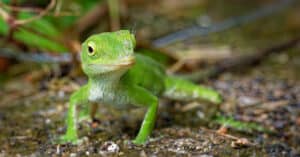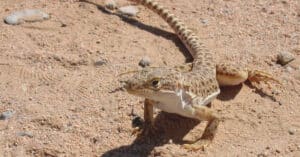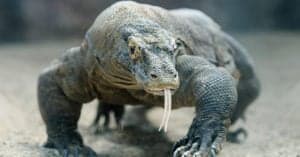Are Lizards Poisonous? And 3 Types of Venomous Lizards
@media (min-width: 481px) {
.mobile-top-content {
display: none;
}
}
#mobileTopContentCTACarouselControls { overflow: hidden; text-overflow: ellipsis; white-space: nowrap; }
.mobile-top-content .more { color: #fff; }
.mobile-top-content a { color: #fff; text-decoration: underline; }
.mobile-top-content a:hover { color: #fff; text-decoration: underline; }
@media (max-width: 480px) {
.mobile-top-content {
background-color: #06a10b;
color: #fff;
text-align: center;
/*height: 60px;
padding-top:5px;*/
font-size:80%;
/* display: block; */
margin: 0px -30px;
}
}
Despite their obvious dangers, poisonous and venomous animals have always fascinated humans. From fearsome snakes and toxic frogs to more unusual animals like scorpions and cone snails with powerful stingers, the types of animals that can utilize some kind of poison or venom are numerous and surprisingly varied. Rarely, though, do we study or think about lizards and their potential for toxicity–and are lizards poisonous or venomous, anyway?
Let’s take a look at the difference between poison and venom and whether there are any lizards that possess and can utilize either of the dangerous substances.
Venomous Vs. Poisonous: What’s the Difference?
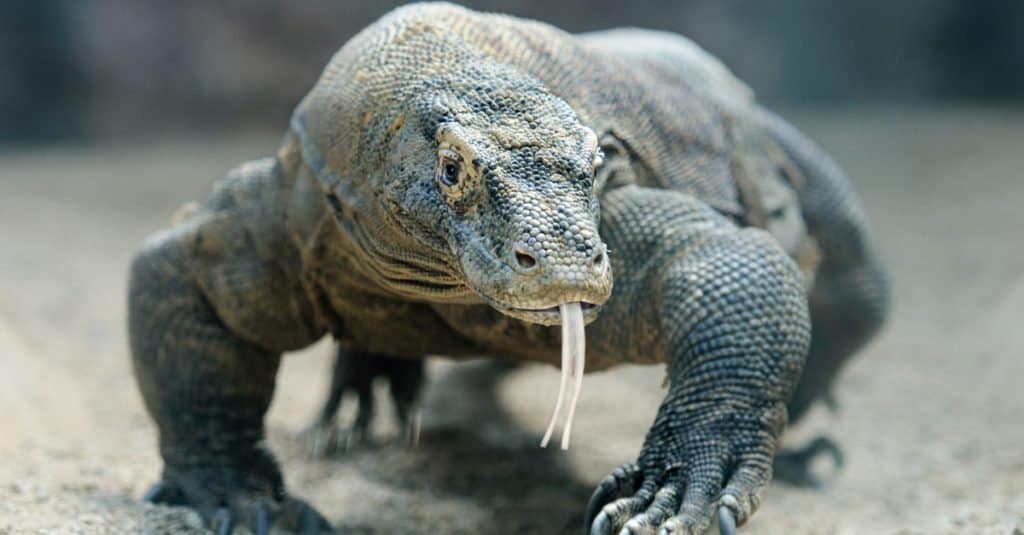
iStock.com/photomaru
Before any sort of discussion about venomous and poisonous animals, it helps to have a refresher when it comes to the actual differences between venom and poison and why this distinction is so important. While many people use the terms interchangeably, they have a few key differences.
Both venom and poison are toxic substances some animals can secrete as a defense mechanism or to incapacitate prey. However, the ways animals deliver poison versus venom are very different.
Venomous animals deliver their venom via biting or stinging. Some animals, like snakes, use their fangs or teeth, while others have toxic spines or stingers somewhere on their bodies to inject their prey (or even an imposing predator) with venom.
There are four types of venom: neurotoxic, hemotoxic, myotoxic, and cytotoxic/necrotoxic. Neurotoxic venom, as the name implies, can disable or shut down parts of an affected animal’s nervous system. Hemotoxic venom interferes with blood clotting. Myotoxic venom can damage muscle tissue. Finally, cytotoxic venom, also known as necrotoxic venom, causes cell death in an affected animal’s body.
Poisonous animals, on the other hand, are more passive and indirect in the way they deliver their toxins. Poison is used more as a defense mechanism rather than a means of taking down prey. Poisonous animals typically secrete their toxins from their skin. Many poisonous species, such as the famous poison dart frog, are brightly colored to warn predators of their toxicity.
Essentially, if an animal bites or stings you to deliver a toxin, it’s venomous. If you have to bite or touch it to come in contact with the toxin, the animal is poisonous! In rare cases, some animals, like the tiger keelback snake, can be both!
Are There Any Poisonous or Venomous Lizards?
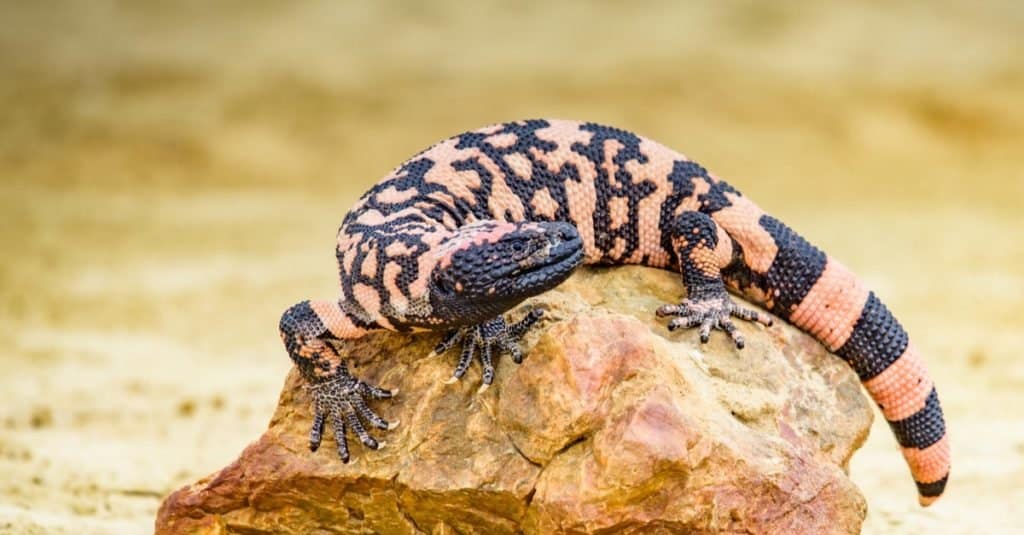
Vaclav Sebek/Shutterstock.com
But back to the main topic at hand: are any lizards poisonous or venomous? It turns out, there are no known species that are poisonous. There are, however, a few that are able to deliver potent, specialized venom via their bite. These include the Gila monster, the Mexican beaded lizard, and the Komodo dragon.
More recent research suggests most lizards do, in fact, possess weak, primitive venom glands, but they are only harmful to small prey animals.
While the Gila monster and Mexican beaded lizard both have striking appearances and fearsome reputations, human fatalities from their venom are virtually nonexistent. Both lizards are within the same genus and live within a similar geographic range. Additionally, both species are small, fairly reclusive, and slow-moving, so their overall danger to humans is pretty low. Still, their bites can certainly be very painful and typically require prompt medical attention.
Interestingly, newer research is beginning to suggest that many more lizards are venomous than we initially thought! Even the beloved bearded dragon is now believed to possess very small and weak venom glands, which they use to take down small prey. Thankfully, the vast majority of these species’ venom is nowhere near potent enough to seriously harm us (or anything much larger than a mouse).
Meanwhile, Komodo dragons can certainly be aggressive if provoked, and their venom is dangerous to humans. However, they live in such an isolated area that they don’t come in contact with, let alone seek out, humans very often. They have been known to occasionally attack villagers living amongst them on the islands of Komodo, Rinca, Flores, and Gili Motang in Indonesia, but fatalities are few and far between.
Venomous Lizards: The Gila Monster
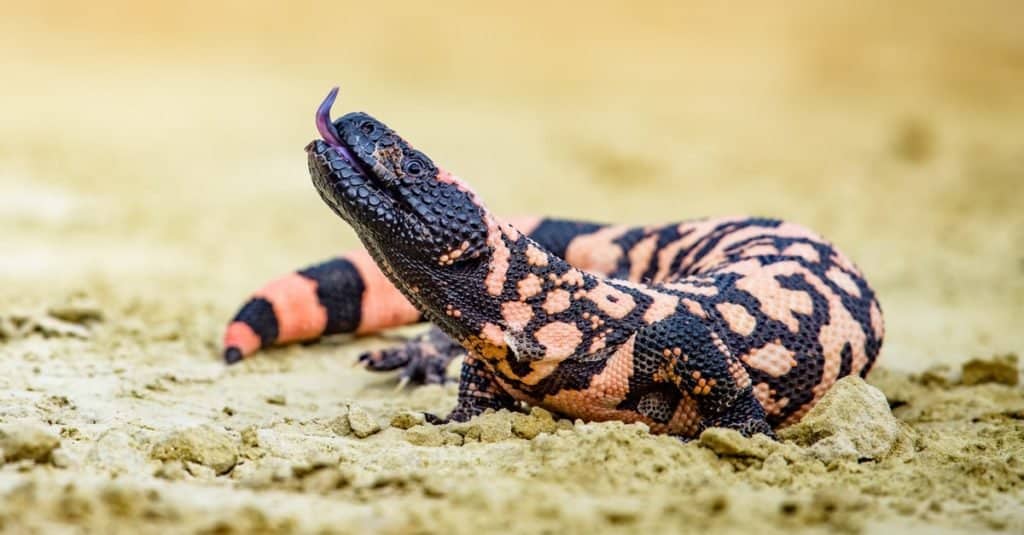
Vaclav Sebek/Shutterstock.com
The Gila monster is perhaps the most famous venomous lizard in the world! These slow, chubby little orange and black lizards with bead-like scales are native to northwestern Mexico as well as several states throughout the southwestern United States. They’re only around 20 to 24 inches long and rarely weigh more than a few pounds.
Despite their small size, Gila monsters are quite skilled at delivering venom to prey and even using it as a defense mechanism. They use modified salivary glands in their lower jaws to produce their venom. Their teeth are short, sharp, and pleurodont in nature, so they are secured directly to the surface of the lizard’s jaws. These small teeth have tiny grooves in them which help Gila monsters to better latch onto their prey.
When they want to use their venom, they will bite an animal tightly and sort of “chew” on them to dig their teeth deeper into the animal’s flesh. They will then release their neurotoxic venom through their modified venom glands, which will flow into the animal’s wound with the help of the Gila monster’s sharp, jagged teeth.
While this bite can be extremely painful and deadly to some small prey animals, it’s rare for a Gila monster to bite a human. They’re far more likely to flee from us than attack, as they are very shy animals. What’s more, their venom just isn’t potent enough to be fatal to humans.
Venomous Lizards: The Beaded Lizard

Danny Ye/Shutterstock.com
The Mexican beaded lizard is a close relative of the aforementioned Gila monster! They’re actually classified within the same genus, Heloderma. This genus includes four subspecies of Mexican beaded lizards, all of which are very similar in size and appearance. They are, however, a lot larger than Gila monsters and can reach three feet in length. Additionally, their venom is hemotoxic in nature rather than neurotoxic.
Despite their somewhat intimidating size, beaded lizards are about as dangerous to humans as the Gila monster–that is to say, they aren’t very dangerous at all, though you definitely shouldn’t handle one directly if you happen to encounter them in the wild. They have a very similar means of delivering venom as the Gila monster. While this venom is deadly to small prey animals, it doesn’t stand a chance against humans.
Unusually, although beaded lizards are carnivores with quite efficient venom glands, they mostly feed on other animals’ eggs. Bird and reptile eggs seem to be their preferred fare, and over time, they’ve become skilled climbers to seek out nests to eat from.
Although beaded lizard bites are almost never fatal, prompt medical attention is still necessary to treat them. Their hemotoxic venom can interfere with blood clotting and cause respiratory issues.
Venomous Lizards: The Komodo Dragon
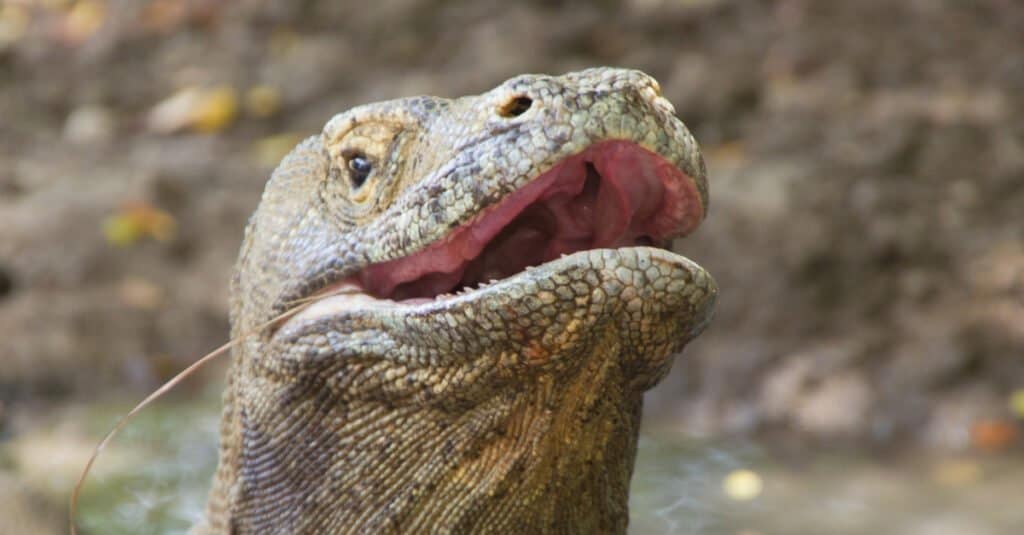
vladivlad/Shutterstock.com
Finally, we come to the last notable truly venomous species: the absolutely enormous Komodo dragon! As the largest lizards in the world, Komodo dragons look like something straight out of Jurassic Park. These monitor lizards commonly weigh well over 120 pounds and reach lengths of 10 feet from nose to tail tip!
This particular species is a unique member of this list for a few reasons. For many years, researchers simply believed the Komodo dragon wasn’t venomous at all but rather possessed such dirty, bacteria-packed saliva that it primarily killed its prey via sepsis. In more recent years, though, we’ve found that this is most likely not the case.
It turns out, Komodo dragons have been found to possess venom glands that secrete toxic proteins. And these toxic proteins function very similarly to those in hemotoxic venom! More specifically, the toxins prevent blood clotting and cause muscle paralysis in affected animals. Still, more research is needed for us to fully understand the nature of Komodo dragon venom.
More from A-Z Animals
.more-snake-card-image { max-height:140px !important; }
@media (min-width: 481px) {
.mobile-top-content {
display: none;
}
}
#mobileTopContentCTACarouselControls { overflow: hidden; text-overflow: ellipsis; white-space: nowrap; }
.mobile-top-content .more { color: #fff; }
.mobile-top-content a { color: #fff; text-decoration: underline; }
.mobile-top-content a:hover { color: #fff; text-decoration: underline; }
@media (max-width: 480px) {
.mobile-top-content {
background-color: #06a10b;
color: #fff;
text-align: center;
/*height: 60px;
padding-top:5px;*/
font-size:80%;
/* display: block; */
margin: 0px -30px;
}
}
Despite their obvious dangers, poisonous and venomous animals have always fascinated humans. From fearsome snakes and toxic frogs to more unusual animals like scorpions and cone snails with powerful stingers, the types of animals that can utilize some kind of poison or venom are numerous and surprisingly varied. Rarely, though, do we study or think about lizards and their potential for toxicity–and are lizards poisonous or venomous, anyway?
Let’s take a look at the difference between poison and venom and whether there are any lizards that possess and can utilize either of the dangerous substances.
Venomous Vs. Poisonous: What’s the Difference?

iStock.com/photomaru
Before any sort of discussion about venomous and poisonous animals, it helps to have a refresher when it comes to the actual differences between venom and poison and why this distinction is so important. While many people use the terms interchangeably, they have a few key differences.
Both venom and poison are toxic substances some animals can secrete as a defense mechanism or to incapacitate prey. However, the ways animals deliver poison versus venom are very different.
Venomous animals deliver their venom via biting or stinging. Some animals, like snakes, use their fangs or teeth, while others have toxic spines or stingers somewhere on their bodies to inject their prey (or even an imposing predator) with venom.
There are four types of venom: neurotoxic, hemotoxic, myotoxic, and cytotoxic/necrotoxic. Neurotoxic venom, as the name implies, can disable or shut down parts of an affected animal’s nervous system. Hemotoxic venom interferes with blood clotting. Myotoxic venom can damage muscle tissue. Finally, cytotoxic venom, also known as necrotoxic venom, causes cell death in an affected animal’s body.
Poisonous animals, on the other hand, are more passive and indirect in the way they deliver their toxins. Poison is used more as a defense mechanism rather than a means of taking down prey. Poisonous animals typically secrete their toxins from their skin. Many poisonous species, such as the famous poison dart frog, are brightly colored to warn predators of their toxicity.
Essentially, if an animal bites or stings you to deliver a toxin, it’s venomous. If you have to bite or touch it to come in contact with the toxin, the animal is poisonous! In rare cases, some animals, like the tiger keelback snake, can be both!
Are There Any Poisonous or Venomous Lizards?

Vaclav Sebek/Shutterstock.com
But back to the main topic at hand: are any lizards poisonous or venomous? It turns out, there are no known species that are poisonous. There are, however, a few that are able to deliver potent, specialized venom via their bite. These include the Gila monster, the Mexican beaded lizard, and the Komodo dragon.
More recent research suggests most lizards do, in fact, possess weak, primitive venom glands, but they are only harmful to small prey animals.
While the Gila monster and Mexican beaded lizard both have striking appearances and fearsome reputations, human fatalities from their venom are virtually nonexistent. Both lizards are within the same genus and live within a similar geographic range. Additionally, both species are small, fairly reclusive, and slow-moving, so their overall danger to humans is pretty low. Still, their bites can certainly be very painful and typically require prompt medical attention.
Interestingly, newer research is beginning to suggest that many more lizards are venomous than we initially thought! Even the beloved bearded dragon is now believed to possess very small and weak venom glands, which they use to take down small prey. Thankfully, the vast majority of these species’ venom is nowhere near potent enough to seriously harm us (or anything much larger than a mouse).
Meanwhile, Komodo dragons can certainly be aggressive if provoked, and their venom is dangerous to humans. However, they live in such an isolated area that they don’t come in contact with, let alone seek out, humans very often. They have been known to occasionally attack villagers living amongst them on the islands of Komodo, Rinca, Flores, and Gili Motang in Indonesia, but fatalities are few and far between.
Venomous Lizards: The Gila Monster

Vaclav Sebek/Shutterstock.com
The Gila monster is perhaps the most famous venomous lizard in the world! These slow, chubby little orange and black lizards with bead-like scales are native to northwestern Mexico as well as several states throughout the southwestern United States. They’re only around 20 to 24 inches long and rarely weigh more than a few pounds.
Despite their small size, Gila monsters are quite skilled at delivering venom to prey and even using it as a defense mechanism. They use modified salivary glands in their lower jaws to produce their venom. Their teeth are short, sharp, and pleurodont in nature, so they are secured directly to the surface of the lizard’s jaws. These small teeth have tiny grooves in them which help Gila monsters to better latch onto their prey.
When they want to use their venom, they will bite an animal tightly and sort of “chew” on them to dig their teeth deeper into the animal’s flesh. They will then release their neurotoxic venom through their modified venom glands, which will flow into the animal’s wound with the help of the Gila monster’s sharp, jagged teeth.
While this bite can be extremely painful and deadly to some small prey animals, it’s rare for a Gila monster to bite a human. They’re far more likely to flee from us than attack, as they are very shy animals. What’s more, their venom just isn’t potent enough to be fatal to humans.
Venomous Lizards: The Beaded Lizard

Danny Ye/Shutterstock.com
The Mexican beaded lizard is a close relative of the aforementioned Gila monster! They’re actually classified within the same genus, Heloderma. This genus includes four subspecies of Mexican beaded lizards, all of which are very similar in size and appearance. They are, however, a lot larger than Gila monsters and can reach three feet in length. Additionally, their venom is hemotoxic in nature rather than neurotoxic.
Despite their somewhat intimidating size, beaded lizards are about as dangerous to humans as the Gila monster–that is to say, they aren’t very dangerous at all, though you definitely shouldn’t handle one directly if you happen to encounter them in the wild. They have a very similar means of delivering venom as the Gila monster. While this venom is deadly to small prey animals, it doesn’t stand a chance against humans.
Unusually, although beaded lizards are carnivores with quite efficient venom glands, they mostly feed on other animals’ eggs. Bird and reptile eggs seem to be their preferred fare, and over time, they’ve become skilled climbers to seek out nests to eat from.
Although beaded lizard bites are almost never fatal, prompt medical attention is still necessary to treat them. Their hemotoxic venom can interfere with blood clotting and cause respiratory issues.
Venomous Lizards: The Komodo Dragon

vladivlad/Shutterstock.com
Finally, we come to the last notable truly venomous species: the absolutely enormous Komodo dragon! As the largest lizards in the world, Komodo dragons look like something straight out of Jurassic Park. These monitor lizards commonly weigh well over 120 pounds and reach lengths of 10 feet from nose to tail tip!
This particular species is a unique member of this list for a few reasons. For many years, researchers simply believed the Komodo dragon wasn’t venomous at all but rather possessed such dirty, bacteria-packed saliva that it primarily killed its prey via sepsis. In more recent years, though, we’ve found that this is most likely not the case.
It turns out, Komodo dragons have been found to possess venom glands that secrete toxic proteins. And these toxic proteins function very similarly to those in hemotoxic venom! More specifically, the toxins prevent blood clotting and cause muscle paralysis in affected animals. Still, more research is needed for us to fully understand the nature of Komodo dragon venom.


